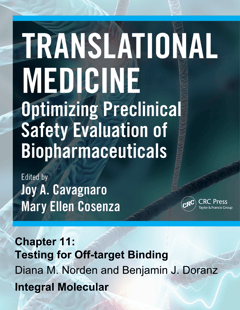IND-Ready Study Report
The MPA is a cell-based platform that provides detailed specificity information by testing molecules against an array of 6,000 human membrane proteins expressed in live cells. To support our customers who require this information for regulatory filings, we offer the MPA+IND level of service. MPA+IND includes all the same high-quality data as the standard MPA service; however, it additionally provides:
- A full IND-ready study report that can be directly incorporated into an IND safety package
- Additional isotype controls to further validate binding interactions
- Data traceability and auditability
- Up to 8 hours of post-project and audit support
MPA+IND Services
| MPA | MPA + IND | |
| Testing against 6,000 membrane proteins | ✔ | ✔ |
| Testing in duplicate | ✔ | ✔ |
| Epitope tags to ensure protein expression | ✔ | ✔ |
| Native binding conditions (unfixed cells) | ✔ | ✔ |
| Flow cytometry detection for sensitivity | ✔ | ✔ |
| Assay setup for optimal conditions | ✔ | ✔ |
| Hit validation curve to confirm reactivity | ✔ | ✔ |
| Turnaround time | 6-8 weeks | 4 weeks |
| Additional isotype control validation | - | ✔ |
| IND-Ready study report | - | ✔ |
| Audit support | - | ✔ |
| IND-enabled data tracking | - | ✔ |
| IND-traceable SOPs | - | ✔ |
| QA documentation of personnel | - | ✔ |
| QA documentation of equipment | - | ✔ |
| Records retention | 3 years | 10 years |
Services may vary slightly depending on customer location.
References
- Cunningham, O. et al. (2021) Polyreactivity and polyspecificity in therapeutic antibody development: risk factors for failure in preclinical clinical development campaigns. mAbs. 13(1): E1999195.
- Norden, D. and Doranz, B. Testing for Off-target Binding. In: Cavagnaro, JA., and Cosenza, ME. Translational Medicine: Optimizing Preclinical Safety Evaluation of Biopharmaceuticals. CRC Pres; 2021. doi.org/10.1201/9781003124542.
- MacLachlan, T.K. et al. (2021). Industry experiences with immune-mediated findings in biotherapeutic nonclinical toxicology studies. Regul Toxicol Pharmacol. 119:104825.
Frequently Asked Questions
Cross-reactivity screening is required for IND and BLA applications. Demonstrating a lack of off-target binding is especially important for therapeutic modalities with high cell-killing potential such as CAR-T cell therapies. The MPA+IND service provides an IND-ready study report that is designed to be directly incorporated into an IND safety package, and has successfully been used in IND submissions to satisfy cross-reactivity testing requirements.
Yes, many of our customers use the MPA for screening of their T-cell therapeutics (including CAR-T, CAART, and bicistronic CAR vectors). We have several screening options available for screening CAR-T modalities. Please contact us to discuss screening of your T cell therapeutic.
Cell arrays, such as the MPA, are increasingly used and accepted by the FDA for specificity screening of most biotherapeutics. In some cases, cell array was the sole assay used in approved IND applications and no TCR data were submitted (MacLachlan et al., 2021).
The MPA precisely identifies cross-reactive binding partners whereas TCR studies identify tissues where the test article binds, without specifying the binding proteins involved. By providing specific binding identities, the MPA screen enables follow-up studies that can more accurately assess the physiological relevance or potential toxicity of any off-target interactions. The MPA uses unfixed cells which present targets in their native conformations and enables the most accurate assessment of relevant binding interactions. Other differences include flow-cytometry detection, high sensitivity, and low false positive rates.
MPA data can be used to provide specificity profiling for regulatory submissions globally, including to the FDA, EMA, PDMA and NMPA.
Case Study
 Learn How Cabaletta Bio Used the MPA for a Successful IND Submission
Learn How Cabaletta Bio Used the MPA for a Successful IND Submission
Autoantibodies against desmoglein 3 (DSG3) cause painful mucosal blisters in mucosal pemphigus vulgaris (mPv). Cabaletta Bio developed DSG3-CAART (Chimeric AutoAntibody Receptor T cell) therapy to eliminate these autoantibodies by targeting the corresponding pool of antigen-specific B cells. To progress the clinical development, Cabaletta Bio needed to demonstrate the specificity of DSG3-CAART and document the lack of off-target interactions for their IND submission.
Contact Us
Towards IND: Specificity Profiling of Antibody Therapies Using the Membrane Proteome Array
Webinar Agenda
- Re-examine the long-held assumption that antibodies are exquisitely specific
- Learn what to do next if your molecule shows detectable off-target binding
- Discover how Membrane Proteome Array specificity data is used to satisfy regulatory requirements


